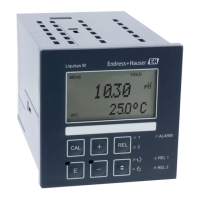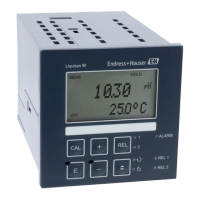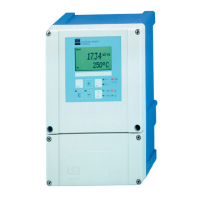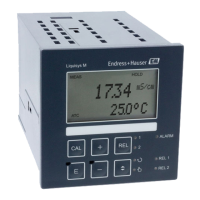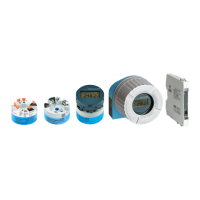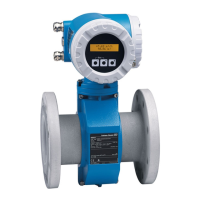Maintenance Liquisys M CCM223/253
96 Endress+Hauser
NOTICE
Prohibited cleaning agents
Damage to the housing surface or housing seal
‣
Never use concentrated mineral acids or alkaline solutions for cleaning.
‣
Never use organic cleaners such as benzyl alcohol, methanol, methylene chloride,
xylene or concentrated glycerol cleaner.
‣
Never use high-pressure steam for cleaning purposes.
9.1.2 Cleaning the pH/mV sensors (EP version)
L
CAUTION
Cleaning not switched off during calibration or maintenance activities
Risk of injury due to medium or cleaning agent
‣
If a cleaning system is connected, switch if off before removing a sensor from the
medium.
‣
If you wish to check the cleaning function and have therefore not switched off the
cleaning system, please wear protective clothing, goggles and gloves or take other
appropriate measures.
L
CAUTION
Risk of injury from cleaning agents
‣
When using the following cleaning agents, make sure to protect your hands, eyes and
clothing.
Please clean contamination on the glass electrodes as follows:
• Oily and greasy films:
Clean with hot water or temperature-controller detergent (grease remover, e.g. alcohol,
acetone, possibly dishwashing detergent).
• Lime and metal hydroxide buildup:
Dissolve buildup with diluted hydrochloric acid (3 %) and then rinse thoroughly with
plenty of clear water.
• Sulfidic buildup (from flue gas desulfurization or sewage treatment plants):
Use a mixture of hydrochloric acid (3 %) and thiocarbamide (commercially available) and
then rinse thoroughly with plenty of clear water.
• Buildup containing proteins (e.g. food industry):
Use a mixture of hydrochloric acid (0.5 %) and pepsin (commercially available) and then
rinse thoroughly with plenty of clear water.
• Fibers, suspended substances:
Pressurized water, surface-active agents if necessary
• Light biological buildup:
Pressurized water
ORP electrodes:
Carefully clean the metal pins or surfaces mechanically.
After mechanical cleaning, the ORP sensor can require several hours conditioning
time. For this reason, check the calibration after one day.
ISFET sensors
• Never use acetone to clean ISFET sensors as this could damage the material.
• After being cleaned with compressed air, ISFET sensors require approx. 5 to 8 minutes
until the closed-control loop is re-established and the measured value has adjusted to
the real value.
Clogged membranes can be cleaned mechanically under certain circumstances (does not
apply to ISFET sensors, Teflon membranes and open ring junction electrodes):
• Use a small warding file.
• Only file in one direction.
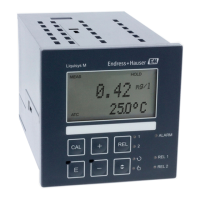
